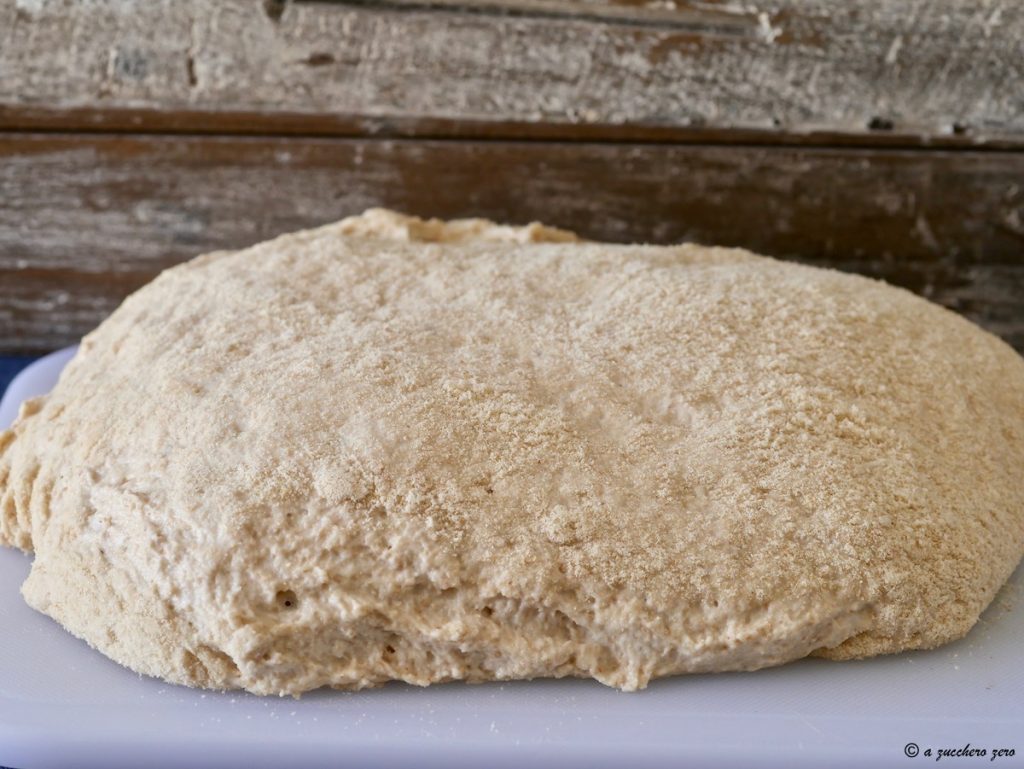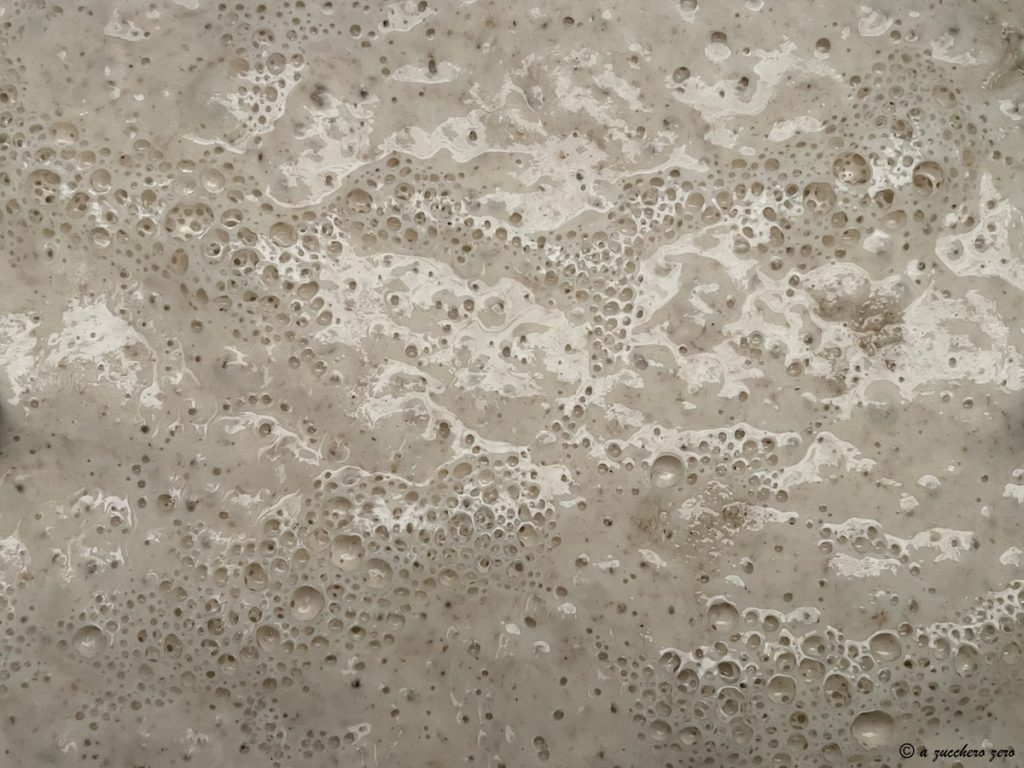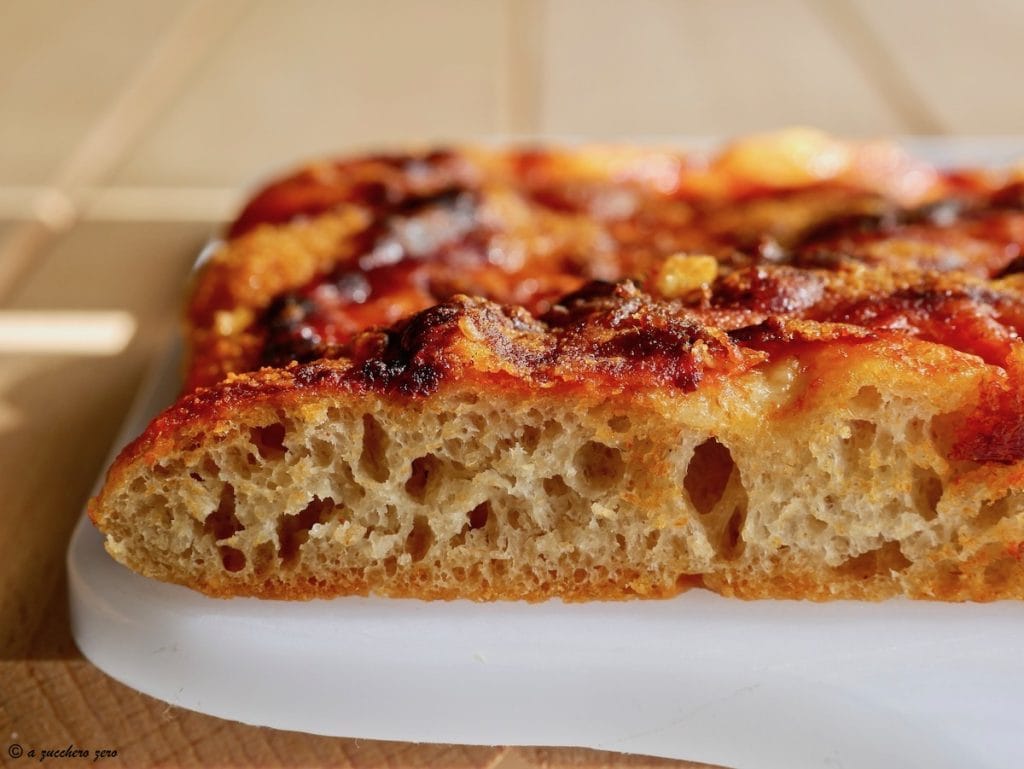The whole wheat dough for pizza, focaccia, and savory pies is a versatile dough with which to prepare pizza, focaccia, and savory pies that are low glycemic and high in fiber.
• process with bread machine and without bread machine;
• poolish method or liquid pre-dough [1 g of dried brewer’s yeast, 12 hours of maturation];
• three rising phases of 40 minutes each, total 2 hours + rising in baking dish/pan/mold.

- Rest time: 14 Hours
- Cuisine: Italian
Ingredients
- 1 1/2 cups natural water
- 1 tsp dried brewer's yeast (Mastro Fornaio PANEANGELI)
- 300 g whole wheat durum semolina (stone-ground)
- 2/3 cup natural water
- 300 g type 2 flour
- 1 1/3 tbsp extra virgin olive oil
- 1 pinch salt
As an alternative to 1 g of dried brewer’s yeast, you can use:
• 3 g of fresh brewer’s yeast;
• 4 g of dry sourdough.
* 7 g of dry brewer’s yeast corresponds to 25 g of fresh brewer’s yeast, check the manufacturer’s instructions.
Suggested Tools
- Bread machine Imetec Zero Glu or another model
- Measuring cup graduated glass
- Food scale digital
- Food scale spoon
- Measuring spoons set
- Spatula silicone
- Dough cutter
- Cutting board kneading board
Preparation
WITH BREAD MACHINE
Insert the mixing paddles into the bread container.
Place the bread container into the machine.
Turn on the bread machine [ON].Prepare the ingredients for the poolish:
• 1 1/2 cups of natural water;
• 1 tsp dried brewer’s yeast;
• 300 g of whole wheat durum semolina stone-ground.Out of the 1 1/2 cups of water, heat a small part: about 1/4 cup; it should be warm not hot.
Pour it into a small bowl, add and dissolve the yeast.Place the ingredients into the bread container:
• water;
• water + dissolved yeast;
• whole wheat durum semolina stone-ground.Select Program 13 [bread with little yeast poolish method] and press the START button.
The machine begins kneading for 8 minutes.
Use a silicone spatula to push down the semolina stuck on the edges of the container.
Once the kneading phase is complete, press the STOP button for a few seconds.The poolish needs to mature for 12 hours during which the machine stays idle and does not keep the dough warm.
Personally, after a few minutes, I turn it off [OFF] and set an alarm for 12 hours later.IF YOU DON’T HAVE A BREAD MACHINE, you can use a stand mixer or a hand mixer or simply an immersion blender.
In preparing the poolish without a bread machine, keep in mind that:
• the bread machine kneads for 8 minutes;
• the poolish needs to mature for 12 hours during which the bread machine remains idle and does not keep the dough warm [personally, I turn it off].After 12 hours, the poolish is mature and appears doubled and full of bubbles.
The appearance varies depending on the semolina or flour used.
WITH BREAD MACHINE
Prepare the ingredients for the 2nd dough:
• 2/3 cup of natural water;
• 300 g of type 2 flour;
additionally:
• 1 1/3 tbsp of extra virgin olive oil;
• 1 pinch of salt.Select Program 18 [kneading and rising] which includes:
• a kneading phase of 27 minutes;
• three rising phases of 40 minutes each, total 2 hours;
for a total duration of 2 hours and 27 minutes.
Pour the first 1/4 cup of water over the poolish.
Press the START button and add:
• flour and water bit by bit;
• oil and salt last.
Use a silicone spatula to push down the flour stuck on the edges of the container.
During the rising phases, do not open the lid to avoid temperature fluctuations.
Between each rising phase, the machine will signal.
At the end of the Program, the machine will signal: several beeps, remove the bread container.IF YOU DON’T HAVE A BREAD MACHINE, you can use a stand mixer or a hand mixer for the kneading phase and an off oven or blankets for the rising phases, extending the time until the dough doubles.
Note that:
• the bread machine kneads for 27 minutes;
• the bread machine performs 3 rising phases of 40 minutes each at controlled temperature [it heats].Prepare:
• a kneading board or cutting board to transfer the dough onto;
• a couple of dough cutters.
Use a fine mesh sieve to sprinkle a thin and even layer of semolina on the kneading board or cutting board.
Flip the bread container letting the dough slide onto the kneading board or cutting board.
! Remember to separate the mixing paddles and carefully remove any dough residue from the bread container.Flip the dough again.
The dough is elastic and cohesive, do not overhandle it:
• use a fine mesh sieve to sprinkle a thin and even layer of semolina over the dough;
• with the help of the dough cutters, divide the dough into small loaves.
• a 14 oz loaf for a rectangular pizza pan 12×8 inches;
• a 7 oz loaf for a round pizza pan 9.5 inches in diameter;
• a 7 oz loaf for focaccia in a ciabatta mold provided with the bread machine;
• a 3.5 oz loaf for a bun in a bun mold provided with the bread machine;
• a 1.75-2 oz loaf for savory pies [pizza tongues and mini pizzas, calzones and turnovers, stuffed buns, etc.].Adjust the loaf weights according to the pans/molds you have and the desired result: tall and fluffy or thin and crispy.
Line pans/molds with parchment paper greased with olive oil using a paper towel.
Stretching pizza or focaccia in pans/molds
• stretch the loaf with fingertips starting from the edges and working towards the center;
• let rest in a completely turned-off oven for a couple of hours.All the secrets for a perfect Margherita pizza in a pan here → Margherita pizza [whole wheat base].

Browse the blog section dedicated to ⇒ recipes with the Bread Machine.
FAQ (Questions and Answers)
Can I substitute the flours?
When substituting flours in a dough, remember that:
• each flour has its own characteristics and absorbs a different percentage of water;
• the impact on glycemia can be different → semolina and flours glycemic index.What is type 2 flour?
Type 2 flour is a semi-whole wheat flour, great for baking such as making bread and pizza.
I used a stone-ground type 2 flour from ancient Sicilian wheat variety Perciasacchi [translated bag piercer] or long spelt so-called for the pointy shape of the kernel that used to pierce the jute bags in which it was transported.
It has similar characteristics to Khorasan or Kamut wheat but it is grown in Italy.
It has a low glycemic index and is low [not free] in gluten.
Source: paneecaffepalermo.it.
Other ancient grains: Russello, Senatore Cappelli, Tumminia.
Glycemic Index
• semi-whole wheat flour → GI 65;
• whole wheat flour → GI 60;
• durum wheat semolina → GI 45.Long or short rising?
Today, schools of thought seem to have split.
We still have at our disposal some USEFUL PRECAUTIONS TO REDUCE THE IMPACT OF PIZZA ON GLYCEMIA and we must continue to rely on them.
The glycemic response is personal and the variables are numerous.
• with a glucometer in hand, test your personal response to try to adjust.
Further reading and precautions here → glycemic index pizza.How many grams of pizza dough per person?
Usually, a pizzeria’s dough ball weighs 250 g.
⇒ cook and eat according to your dietary plan.

